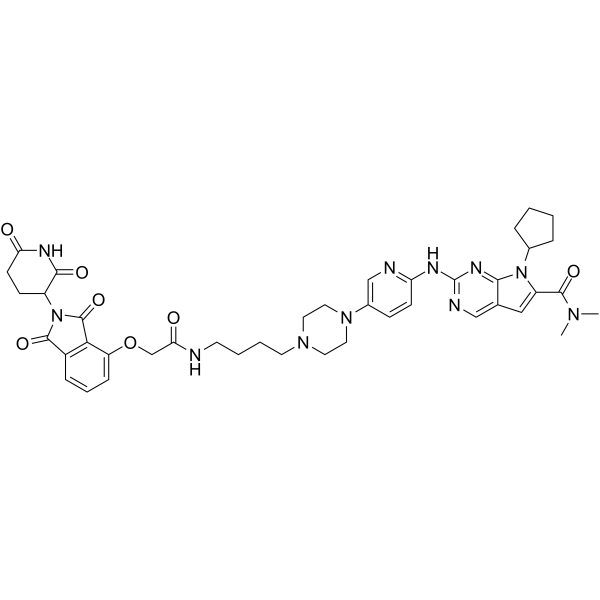Physicochemical Properties
| Molecular Formula | C42H49N11O7 |
| Molecular Weight | 819.9079682827 |
| Exact Mass | 819.381 |
| CAS # | 2349356-39-2 |
| Related CAS # | 2349356-39-2; |
| PubChem CID | 139593562 |
| Appearance | White to yellow solid powder |
| LogP | 2.6 |
| Hydrogen Bond Donor Count | 3 |
| Hydrogen Bond Acceptor Count | 13 |
| Rotatable Bond Count | 14 |
| Heavy Atom Count | 60 |
| Complexity | 1590 |
| Defined Atom Stereocenter Count | 0 |
| SMILES | O=C(C1=CC2=CN=C(NC3C=CC(=CN=3)N3CCN(CCCCNC(COC4=CC=CC5C(N(C(C=54)=O)C4C(NC(CC4)=O)=O)=O)=O)CC3)N=C2N1C1CCCC1)N(C)C |
| InChi Key | GWLSXEHHNOBFOI-UHFFFAOYSA-N |
| InChi Code | InChI=1S/C42H49N11O7/c1-49(2)40(58)31-22-26-23-45-42(48-37(26)52(31)27-8-3-4-9-27)46-33-14-12-28(24-44-33)51-20-18-50(19-21-51)17-6-5-16-43-35(55)25-60-32-11-7-10-29-36(32)41(59)53(39(29)57)30-13-15-34(54)47-38(30)56/h7,10-12,14,22-24,27,30H,3-6,8-9,13,15-21,25H2,1-2H3,(H,43,55)(H,47,54,56)(H,44,45,46,48) |
| Chemical Name | 7-cyclopentyl-2-[[5-[4-[4-[[2-[2-(2,6-dioxopiperidin-3-yl)-1,3-dioxoisoindol-4-yl]oxyacetyl]amino]butyl]piperazin-1-yl]pyridin-2-yl]amino]-N,N-dimethylpyrrolo[2,3-d]pyrimidine-6-carboxamide |
| HS Tariff Code | 2934.99.9001 |
| Storage |
Powder-20°C 3 years 4°C 2 years In solvent -80°C 6 months -20°C 1 month Note: Please store this product in a sealed and protected environment, avoid exposure to moisture. |
| Shipping Condition | Room temperature (This product is stable at ambient temperature for a few days during ordinary shipping and time spent in Customs) |
Biological Activity
| Targets | CDK4/D1 50.6 nM (IC50) CDK6/D1 30 nM (IC50) |
| ln Vitro | In WT cells, BSJ-04-132 (0.1–5 μM) exclusively degrades CDK4; it does not affect CDK6 or IKZF1/3[1]. |
| Cell Assay |
Western Blot Analysis[1] Cell Types: Wildtype (WT) or Crbn-/- Jurkat cells Tested Concentrations: 0.1, 0.5, 1, 5 μM Incubation Duration: For 4 hrs (hours) Experimental Results: Only resulted in degradation of CDK4 in WT cells, not CDK6 and IKZF1/3. |
| References |
[1]. Development of Dual and Selective Degraders of Cyclin-Dependent Kinases 4 and 6. Angew Chem Int Ed Engl. 2019 May 6;58(19):6321-6326. |
Solubility Data
| Solubility (In Vitro) | DMSO : 100 mg/mL (121.96 mM) |
| Solubility (In Vivo) |
Solubility in Formulation 1: ≥ 2.5 mg/mL (3.05 mM) (saturation unknown) in 10% DMSO + 40% PEG300 + 5% Tween80 + 45% Saline (add these co-solvents sequentially from left to right, and one by one), clear solution. For example, if 1 mL of working solution is to be prepared, you can add 100 μL of 25.0 mg/mL clear DMSO stock solution to 400 μL PEG300 and mix evenly; then add 50 μL Tween-80 to the above solution and mix evenly; then add 450 μL normal saline to adjust the volume to 1 mL. Preparation of saline: Dissolve 0.9 g of sodium chloride in 100 mL ddH₂ O to obtain a clear solution. Solubility in Formulation 2: 2.5 mg/mL (3.05 mM) in 10% DMSO + 90% (20% SBE-β-CD in Saline) (add these co-solvents sequentially from left to right, and one by one), suspension solution; with ultrasonication. For example, if 1 mL of working solution is to be prepared, you can add 100 μL of 25.0 mg/mL clear DMSO stock solution to 900 μL of 20% SBE-β-CD physiological saline solution and mix evenly. Preparation of 20% SBE-β-CD in Saline (4°C,1 week): Dissolve 2 g SBE-β-CD in 10 mL saline to obtain a clear solution. Solubility in Formulation 3: ≥ 2.5 mg/mL (3.05 mM) (saturation unknown) in 10% DMSO + 90% Corn Oil (add these co-solvents sequentially from left to right, and one by one), clear solution. For example, if 1 mL of working solution is to be prepared, you can add 100 μL of 25.0 mg/mL clear DMSO stock solution to 900 μL of corn oil and mix evenly. (Please use freshly prepared in vivo formulations for optimal results.) |
| Preparing Stock Solutions | 1 mg | 5 mg | 10 mg | |
| 1 mM | 1.2196 mL | 6.0982 mL | 12.1965 mL | |
| 5 mM | 0.2439 mL | 1.2196 mL | 2.4393 mL | |
| 10 mM | 0.1220 mL | 0.6098 mL | 1.2196 mL |
